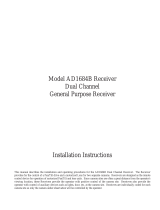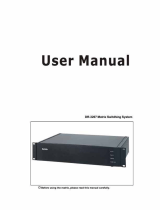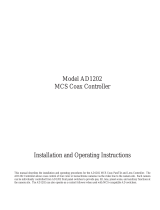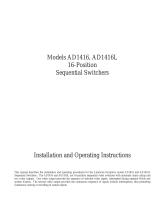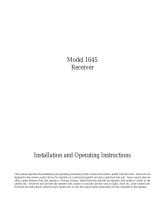Page is loading ...

CM6700 Matrix
Switcher/Controller
Installation/
Operation Manual
C523M-H (6/05)
®
Pelco • 3500 Pelco Way • Clovis, CA 93612-5699 USA • www.pelco.com
In North America and Canada: Tel (800) 289-9100 • FAX (800) 289-9150
International Customers: Tel +1(559) 292-1981 • FAX +1(559) 348-1120

2 Pelco Manual C523M-H (6/05)
CONTENTS
Section Page
IMPORTANT SAFEGUARDS AND WARNINGS ................................................................ 3
MODELS ............................................................................................................................4
ASSOCIATED EQUIPMENT ...................................................................................... 4
DESCRIPTION ...................................................................................................................5
INSTALLATION ..................................................................................................................8
SET OPTIONS ........................................................................................................... 8
MOUNT UNIT .............................................................................................................9
CONNECT VIDEO SOURCES ................................................................................. 10
CONNECT CONTROL LINES ................................................................................... 11
CONNECT MONITORS ............................................................................................ 13
CONNECT ALARMS ................................................................................................. 14
CONNECT AUXILIARIES .........................................................................................15
CONNECT COM 2 PORT ......................................................................................... 17
CONNECT KEYBOARDS ......................................................................................... 18
PROGRAMMING ..............................................................................................................20
OPERATION ..................................................................................................................... 36
ASCII OPERATING COMMANDS ............................................................................ 36
TROUBLESHOOTING ...................................................................................................... 39
GAINING INITIAL CONTROL ................................................................................... 39
USING A PC TO SEND ASCII COMMANDS VIA COM 2 ......................................... 39
PERFORMING A SOFTWARE RESET .....................................................................39
SPECIFICATIONS ............................................................................................................. 41
INDEX ............................................................................................................................... 43
REGULATORY NOTICES ......................................................................................... 44
WARRANTY AND RETURN INFORMATION .................................................................... 44
LIST OF ILLUSTRATIONS
Figure Page
1 CM6700 Applications ......................................................................................... 6
2 Application with a Multiplexer .............................................................................7
3 Applications with Remote Keyboards (ASCII, KBD200A Only) .......................... 7
4 Cover Removal .................................................................................................. 8
5Video Termination Jumpers ................................................................................ 8
6 DIP Switch Locations ......................................................................................... 9
7 Installing Mounting Ears .....................................................................................9
8 Mounting the Matrix Switcher ............................................................................ 10
9 Connecting Video Sources................................................................................10
11 Daisy-Chaining Receivers ................................................................................. 11
10 COM 1 Connections on the SCU ...................................................................... 11
12 Making Receiver Connections at a Distribution Block (CM9760-CDU-T) ......... 12
13 Monitor Connections ......................................................................................... 13
14 Connecting Alarms ............................................................................................ 14
15 Wiring the AUX 1 (Relay) Output ...................................................................... 15
16 Wiring the AUX 2 and AUX 3 (TTL) Outputs ..................................................... 16
17 Connecting an RS-232 Interface ....................................................................... 17
18 Connecting an RS-422/485 Interface ................................................................ 17
19 Installing Local and Remote Keyboards ........................................................... 18
20 Quick Reference Chart ..................................................................................... 21
21 Software Reset Button Location ....................................................................... 39
LIST OF TABLES
Table Page
A Keyboard Addresses .........................................................................................19
B Programming the CM6700 Switching Control Unit ........................................... 20
C Examples of ASCII Commands ......................................................................... 36
D ASCII Commands ............................................................................................. 37
E Solutions To Common Problems ....................................................................... 40
F Switcher/Controller and Keyboard RJ-45 Pin Functions ...................................40

Pelco Manual C523M-H (6/05) 3
IMPORTANT SAFEGUARDS AND WARNINGS
Prior to installation and use of this product, the following WARNINGS should be observed.
1. Installation and servicing should be done only by qualified service personnel and
conform to all local codes.
2. This unit is designed for indoor use only and must not be installed where exposed to
rain and moisture.
3. The installation method and materials should be capable of supporting four times the
weight of the unit and equipment.
4. After replacement/repair of this unit’s electrical components, conduct a resistance
measurement between line and exposed parts to verify the exposed parts have not
been connected to line circuitry.
The product and/or manual may bear the following marks:
Please thoroughly familiarize yourself with the information in this manual prior to installation
and operation.
This symbol indicates that dangerous volt-
age constituting a risk of electric shock is
present within this unit.
This symbol indicates that there are impor-
tant operating and maintenance instructions
in the literature accompanying this unit.
CAUTION:
RISK OF ELECTRIC SHOCK.
DO NOT OPEN.
REGULATORY NOTICES
This equipment has been tested and found to comply with the limits of a Class A digital
device, pursuant to part 15 of the FCC rules. These limits are designed to provide reason-
able protection against harmful interference when the equipment is operated in a commer-
cial environment. This equipment generates, uses, and can radiate radio frequency energy
and, if not installed and used in accordance with the instruction manual, may cause harmful
interference to radio communications. Operation of this equipment in a residential area is
likely to cause harmful interference in which case the user will be required to correct the
interference at his own expense.

4 Pelco Manual C523M-H (6/05)
MODELS
CM6700-MXB2 Matrix switcher/controller with 16 video inputs and 2 monitor outputs,
120 VAC, 50/60 Hz
CM6700-MXB2-X Same as CM6700-MXB2, PAL-configured for 230 VAC and 50 Hz
operation
CM6700-MXB4 Same as CM6700-MXB2 with two-monitor expansion card
(CM6700VMC2) pre-installed
CM6700-MXB4-X Same as CM6700-MXB4, PAL-configured for 230 VAC and 50 Hz
operation
ASSOCIATED EQUIPMENT
KBD100 Desktop keyboard with full switching and programming capabilities
KBD200A Desktop keyboard with full switching and programming capabilities,
plus push-button control of PTZ functions
KBD300A Desktop keyboard with full switching and programming capabilities,
plus joystick control of PTZ functions
CM6700-VMC2 Expansion card with two monitor outputs
CM6700-VMC2-X Expansion card with two monitor outputs, PAL-configured
KBDKIT Wiring kit for connecting KBD100, KBD200A, and KBD300A keyboards
to remote keyboard port; includes two RJ-45 wall blocks and a trans-
former to convert 120 VAC to 12 VAC for keyboard power
KBDKIT-X Wiring kit for connecting KBD100, KBD200A, and KBD300A keyboards
to remote keyboard port; includes two RJ-45 wall blocks and a trans-
former to convert 230 VAC to 12 VAC for keyboard power
CM9760-CDU-T This is a 16-channel RS-422 transmit-only (two-wire and ground) dis-
tributor that is used primarily to install pan and tilt and dome receivers
in a star configuration.

Pelco Manual C523M-H (6/05) 5
DESCRIPTION
Pelco’s CM6700 is a keyboard-controlled cross-point video matrix switcher/control unit
(SCU) that allows you to route up to sixteen video images to as many as four monitors
while controlling camera positions.
Applications
The CM6700 SCU can be controlled from a local or remote keyboard (refer to Figure 1),
used with a multiplexer to display multiple camera views on a monitor (refer to Figure 2),
and interfaced to a distant keyboard via dial-up telephone circuits through appropriate inter-
face equipment (refer to Figure 3). The CM6700 features menu-driven, password-protected
programming. The CM6700 can also be controlled from a personal computer using ASCII
commands.
Keyboards
Camera positioning options can be programmed and controlled from a keyboard. Up to
eight keyboards can be connected to the CM6700 SCU, allowing monitoring stations that
share a common monitor to each have a keyboard. Four different keyboards are available
to use with the CM6700 SCU, each with varying features and different costs. (Keyboard
types can be mixed in a system – See
Associated Equipment
.)
Sequences, Presets, and Patterns
Special programmed operations include sequences, presets and patterns.
A sequence allows you to see a routine of 16 camera views on your monitor over and
over again. The sequence can be operated automatically or manually. The order in which
the views appear and the time each view remains can be programmed.
A preset allows you to direct a pan/tilt/zoom (camera positioning system) to move to a
certain position on command or as a result of an alarm. In addition to moving the
camera, a descriptive title can appear on the screen. (Presets are not available with the
KBD100 keyboard.)
With a pattern you can program a camera positioning system to move around its
viewing area in a repeating pattern. The number and time length of patterns varies with
different positioning systems. (Patterns are not available with the KBD100 keyboard.)
Alarm Inputs
Eighteen alarm inputs are provided. These can be programmed to cause the display to
switch automatically to the camera with the alarm and/or to operate one of three auxiliary
outputs. Sixteen of the inputs are associated with individual cameras. Two of the inputs
activate group camera sequences.
Auxiliary Outputs
Three auxiliary outputs are provided. One output is a relay and two are open collector (TTL)
outputs. Auxiliary outputs are activated at the keyboard (except KBD100).
Protocols
The CM6700 works with Pelco’s Coaxitron
®
‚ D, and P protocol receivers.
Power, Mounting Methods
The CM6700 SCU operates on 120 VAC or 230 VAC, depending on the model. The
compact case mounts in 3-1/2 inches of vertical space in a 19-inch equipment bay or to a
wall or table top.

6 Pelco Manual C523M-H (6/05)
Figure 1. CM6700 Applications
VIDEO INPUTS
1 3 5 7 9 1 13 15
2 4 6 8 10 12 14 16
VIDEO OUTPUTS
1
2
3
4
LOCAL KEYBOARD
REMOTE KEYBOARDS
LOCAL
KEYBOARD
RS-422 (P OR D)
RS-485
KBD100/200A/300A
12 VAC
TRANSFORMER
WALL BLOCK
DATA
CABLE
SHIELDED
TWISTED
PAIR
CM6700 SCU
COAXITRON
DAISY-CHAIN TO
OTHER
RECEIVERS
TO ALARM
CONTACTS
RS-232 TO PC OR
CARD ACCESS
COMPUTER
COAXITRON
RCVR
00044

Pelco Manual C523M-H (6/05) 7
Figure 2. Application with a Multiplexer
Figure 3. Applications with Remote Keyboards (ASCII, KBD200A Only)
VIDEO INPUTS
1 3 5 7 9 11 13 15
2 4 6 8 10 12 14 16
VIDEO OUTPUTS
1
2
3
4
LOOPED VIDEO INPUTS
MULTIPLEXER
CAMERA VIDEO
CM6700 SCU
MULTIPLEXER
LOCAL
KEYBOARD
KBD200A/300A
MULTIPLEXED
VIDEO
*
*
*
ALTERNATE MULTIPLEXED
VIDEO ROUTING THROUGH
A CAMERA INPUT.
00045
KBD200A
MONITOR
VIDEO
CONTROL
FOT
(VIDEO+)
VIDEO
CONTROL
TRANSMITTER RECEIVER
KBD200A
MONITOR
RS-232 FACILITY (PELCOVISION, ETC.)
TO REMOTE KEYBOARD (ASCII)
RS-422 FACILITY (FIBER OPTIC TERMINAL,
ETC.) TO REMOTE KEYBOARD (ASCII)
FOT
(VIDEO+)
PSTN
NOTE: ASCII DOES
NOT SUPPORT
PROGRAMMING
FOT = FIBER OPTIC TERMINAL
VIDEO INPUTS
1 3 5 7 9 1 13 15
2 4 6 8 10 12 14 16
VIDEO OUTPUTS
1
2
3
4
LOCAL
KEYBOARD
00046

8 Pelco Manual C523M-H (6/05)
INSTALLATION
1 SET OPTIONS
1. Refer to Figure 4. Remove the cover.
Figure 4. Cover Removal
2. Refer to Figure 5. Set jumpers according to your system requirements. JP1-JP16 are
used to terminate the video input with a 75-ohm resistor or to unterminate the video
(looping). The factory default has the jumper installed in the terminating position. If you
are connecting only a camera to an input, leave the jumper in the terminating position.
If you are looping the video to another device, move the jumper to the looped position,
and terminate at the equipment connected to the looping output.
REMOVE 6
SCREWS
REMOVE 6
SCREWS
LIFT COVER
OFF
A
B
C
00055
ON
1234
ON
1234
ON
1234
75-OHM TERMINATION
JUMPERS (ONE PER INPUT)
ON
1234
BACK OF SCU
JP1
JP16
NOTE: JUMPER JP1 CORRESPONDS TO VIDEO INPUT 1,
JP2 TO VIDEO INPUT 2, ETC.
75-OHM TERMINATION
JUMPER
TERMINATED LOOPED
KEY
Figure 5. Video Termination Jumpers

Pelco Manual C523M-H (6/05) 9
3. Refer to Figure 6. Set DIP switches.
a. Communication port 2 is available for a PC or remote keyboard operating in ASCII
mode. (Refer to
ASCII Operating Commands
.) Most PC applications require
RS-232. A remote keyboard can require either RS-232 or RS-422, depending on
the communications facility. To find out the required interface, check your PC
serial port information or refer to your keyboard manual. Set DIP switch SW5
(COM 2) for RS-232 or RS-422, according to your system requirements. The
SCU is configured at the factory for RS-422.
b. DIP switches SW1, SW2, SW3 and SW4 are to remain in the factory default posi-
tion (OFF).
c. DIP switch SW6 (COM1) is to remain in factory default position (RS-422).
Figure 6. DIP Switch Locations
4. Replace cover.
2 MOUNT UNIT
1. Select a suitable location for the SCU. It must be within 6 feet (1.8 m) of a suitable
electrical outlet. Do not connect the power yet.
2. Refer to Figure 7. Position mounting ears on the sides of the SCU for the appropriate
mounting. If the ears are not required, leave them off.
ON
1234
ON
1234
ON
1234
ON
12345678
ON
12345678
POWER
TERMINAL
BLOCK
FUSE
TRANSFORMER
ON
12345678
ON
SW5 & 6 DIP SWITCH SETTINGS
RS-422/485 RS-232
12345678
OFF
KEY
ON
SW6 DEFAULTS
TO RS-422
3c
3a
3b
ON
1234
HIGH VOLTAGE
00054
Figure 7. Installing Mounting Ears
POSITION BRACKETS FOR
FLUSH MOUNTING
(WALL OR TABLE TOP)
POSITION BRACKETS FOR
UNDER-TABLE MOUNTING
POSITION BRACKETS FOR
RACK MOUNTING (REAR)
NOTE: EACH SCU COMES WITH
2 MOUNTING BRACKETS

10 Pelco Manual C523M-H (6/05)
3. Refer to Figure 8. Use suitable hardware to mount the SCU an in equipment bay or
against a flat surface, according to your installation requirements.
Figure 8. Mounting the Matrix Switcher
MOUNT TO RACK OR SURFACE
WITH 4 SCREWS
3 CONNECT VIDEO SOURCES
Refer to Figure 9. Connect video cables at the appropriate BNC receptacles on the back of
the SCU.
Figure 9. Connecting Video Sources
13 579
246810
11
12 14
13 15
16
1
2
VIDEO INPUTS
VIDEO OUTPUTS
ALARMS
(1-9)
ALARMS
(10-18)
COM 1 (1-6)
COM 2 ( 7-12)
CONTROL
OUTPUTS
REMOTE KEYBOARD(S)
LOCAL
KEYBOARD
12 3456789
10
11
12 13 14 15 16 17 18
1 2345 6789
10
11
12
01 23
F
2
F
3
N
O
N
C
C
O
M
TT RR
+ +
CAMERA 15
CM6700 SCU
LOOPING OUT
3
4
CAMERA 1

Pelco Manual C523M-H (6/05) 11
4 CONNECT CONTROL LINES
1. Connect camera control lines to receivers. If your video sources are all controlled by
Coaxitron, skip this section and go to step 5 . If any of your video sources are using D
or P protocol via RS-422 communications circuits, they will connect at COM 1 on the
back of the SCU, as outlined below.
2. Refer to Figure 10. Connect control lines to COM 1 at the connector on the back of the
SCU.
NOTE:
If D or P protocol
receivers are used, they must
all be the same protocol. D
and P protocol receivers
cannot be mixed on the
SCU’s communication port.
Coaxitron control may be
used for some of your
sources when either D or P
protocol receivers are used.
Figure 10. COM 1 Connections on the SCU
TO RECEIVERS
12-PIN PLUG-IN
CONNECTOR
COM 1 (1-6)
COM 2 (7-12)
NOTE: TO PROPERLY
SHIELD DATA CABLE
CONNECT GROUND
ON ONE END ONLY
CONNECT PINS 5 & 6 ONLY IF
USING BI-DIRECTIONAL CONTROL
VIDEO INPUTS
1 3 5 7 9 1 13 15
2 4 6 8 10 12 14 16
VIDEO OUTPUTS
1
2
3
4
LOCAL
KEYBOARD
COM 1 (1-6)
RS-422
PIN ASSIGNMENTS
PIN FUNCTION
1T+
2T–
3 (OPTIONAL) GND
4 NC
5R–
6R+
00052
3. Connect wiring to all receivers.
a. Daisy-chaining (going from one receiver to another) is recommended (refer to
Figure 11) but not always possible.
NOTE:
Unless you have
receivers that are equipped
for bi-directional control, you
will only need to run two
wires (TX+ and TX-) to each
receiver.
Figure 11. Daisy-Chaining Receivers
VIDEO INPUTS
1 3 5 7 9 1 13 15
2 4 6 8 10 12 14 16
VIDEO OUTPUTS
1
2
3
4
LOCAL
KEYBOARD
00050
TO SCU
12-PIN PLUG-IN
CONNECTOR
COM 1 (1-6)
COM 2 (7-12)
NOTE: TO PROPERL
Y
SHIELD DATA CABLE
CONNECT GROUND
ON ONE END ONLY
CONNECT PINS 5 & 6 ONLY
FOR BI-DIRECTIONAL CONTROL
DAISY-CHAINING
RECEIVER 2 RECEIVER 1
RX- RX-
RX+ RX+
TO ADDITIONAL
RECEIVERS

12 Pelco Manual C523M-H (6/05)
b. A star configuration (going to each receiver from a central connecting point) is
sometimes more practical. Your installation will be easier to maintain and trouble-
shoot if you make all connections at a distribution block made of barrier terminals
or at a Pelco CM9760-CDU-T distribution panel (refer to Figure 12). The total
length of all control lines combined should not exceed 4,000 feet (1,219 m).
Figure 12. Making Receiver Connections at a Distribution Block (CM9760-CDU-T)
ALARMS
(1-9)
ALARMS
(10-18)
COM 1 (1-6)
COM 2 (7-12)
CONTROL
OUTPUTS
REMOTE KEYBOARD(S)
LOCAL
KEYBOARD
1 23456789
10
11
1213 14 15 16 17 18
12345678910
11
12
012 3
F
2
F
3
N
O
N
C
C
O
M
TT RR
+ +
Tx+
Tx-
Gnd
Tx+
Tx-
Gnd
Tx+
Tx-
Gnd
Tx+
Tx-
Gnd
Tx+
Tx-
Gnd
Tx+
Tx-
Gnd
Tx+
Tx-
Gnd
Tx+
Tx-
Gnd
Tx+
Tx-
Gnd
Tx+
Tx-
Gnd
Tx+
Tx-
Gnd
Tx+
Tx-
Gnd
Tx+
Tx-
Gnd
Tx+
Tx-
Gnd
Tx+
Tx-
Gnd
Tx+
Tx-
Gnd
12 3
4
56 7 891011121 13 14 15 16
10-24 AC/DC
OUT IN
100-240V
RECEIVER 1
RECEIVER 2
NOTE: USE
CM9760-CDU-T
ONLY WITH
2-WIRE
CONTROL.
NOTE: TO PROPERLY
SHIELD DATA CABLE
CONNECT GROUND
ON ONE END ONLY.
TO SCU
13579
246810
11
12 14
13 15
16
1
2
VIDEO INPUTS
VIDEO OUTPUTS
ALARMS
(1-9)
ALARMS
(10-18)
COM 1 (1-6)
COM 2 (7-12)
CONTROL
OUTPUTS
REMOTE KEYBOARD(S)
LOCAL
KEYBOARD
1 23456789
10
11
1213 14 15 1617 18
1 23456789
10
11
12
0123
F
2
F
3
N
O
N
C
C
O
M
TT RR
+ +
3
4

Pelco Manual C523M-H (6/05) 13
5 CONNECT MONITORS
1. Your SCU will support either two or four monitors. Models CM6700-MXB4 and
CM6700-MXB4-X support four monitors (Monitors 1-4). Models CM6700-MXB2 and
CM6700-MXB2-X support two monitors (Monitor 1 and 2). A CM6700-VMC2 expan-
sion card can be added to the CM6700-MXB2 or a CM6700-VMC2-X to the
CM6700-MXB2-X to increase the support to four monitors.
2. Install monitors according to the instructions provided with them.
3. Refer to Figure 13. Connect the monitor cables at the appropriate BNC receptacle on
the back of the SCU.
4. Be sure to terminate cables properly at the monitors.
Figure 13. Monitor Connections
VIDEO INPUTS
1 3 5 7 9 1 13 15
2 4 6 8 10 12 14 16
VIDEO OUTPUTS
1
2
3
4
LOCAL
KEYBOARD
CM6700 SCU
MONITOR
1
MONITOR
2
MONITOR
3
MONITOR
4a
MONITOR
4b
Ω
75
Ω
75
Ω
75
Ω
75
LOOPING
00049

14 Pelco Manual C523M-H (6/05)
6 CONNECT ALARMS
1. Refer to Figure 14. Alarm inputs 1-16 correspond to video inputs 1-16. If an open door
sensor is connected to alarm input 1, when the sensor is activated the video image
from camera 1 will be displayed on one of the four monitors and the camera will move
to a preset (determined by programming). Alarm sensors can be either N.O. or N.C.
contacts. Connect wires from the sensors to the respective alarm input points on the
connectors at the back of the SCU. Each sensor requires one wire to the alarm input
terminal and a return wire to one of the ground terminals on the connector.
2. Alarm inputs 17 and 18 correspond to group sequences 1 and 2. During a group
sequence four video inputs are sequentially shown on a monitor. Each of the four
monitors can be programmed to show the images from four different video sources.
An alarm sensed at input 17 or 18 causes the respective group sequence to operate.
Connect sensors for these two alarm inputs as described in step 1 above.
Figure 14. Connecting Alarms
VIDEO INPUTS
1 3 5 7 9 1 13 15
2 4 6 8 10 12 14 16
VIDEO OUTPUTS
1
2
3
4
LOCAL
KEYBOARD
VIDEO INPUT CORRESPONDS
TO ALARM INPUT
CAMERA 1
(10)
(11)
(12)
(13)
(14)
(15)
(16)
(17)
(18)
00047
TO ALARM SOURCE
12-PIN PLUG-IN
CONNECTOR
ALARMS
(1-9)
ALARMS
(10-18)
12-PIN TERMINAL STRIP
ON REAR OF SCU

Pelco Manual C523M-H (6/05) 15
7 CONNECT AUXILIARIES
The SCU provides three auxiliary (AUX) outputs for controlling VCRs and other devices.
These outputs can be activated directly from a keyboard by using the F1, F2, and F3 func-
tion keys, or they can be activated by an alarm (determined by programming). Both relay
contacts and TTL outputs are used.
a. AUX 1 is a dry contact relay output. Refer to Figure 15 for wiring details. Terminal
connections are provided for both normally open (N.O.) and normally closed (N.C.)
contacts. Do not exceed the voltage and current ratings for the relay contacts. You will
need to provide an external power source to operate your device. In most cases you
will also need an external current limiting resistor. The formula for calculating the resis-
tor value is given in Figure 15.
b. AUX 2 and 3 are TTL open collector outputs. These outputs provide a path to ground
to control the low voltage trigger inputs on many devices. They can control higher volt-
age control inputs via isolation relays. Refer to Figure 16 for wiring details. Do not ex-
ceed the voltage and current ratings for the TTL outputs. An external pull-up resistor is
usually necessary. The formula for calculating the resistor value is given in Figure 16.
Figure 15. Wiring the AUX 1 (Relay) Output
VIDEO INPUTS
1 3 5 7 9 1 13 15
2 4 6 8 10 12 14 16
VIDEO OUTPUTS
1
2
3
4
LOCAL
KEYBOARD
00048
PIN 1
12-PIN PLUG-IN
CONNECTOR
CONTROL
OUTPUTS
12-PIN TERMINAL STRIP
ON REAR OF SCU
NOT USED
I
o
= OPERATING CURRENT OF THE EXTERNAL DEVICE.
V
o
= RATED OPERATING VOLTAGE OF THE EXTERNAL DEVICE.
R = CURRENT LIMITING RESISTOR.
+VPS = VOLTAGE OF THE EXTERNAL POWER SOURCE.
-VPS = NEGATIVE, COMMON OR GROUND TERMINAL OF EXTERNAL
POWER SOURCE.
NOTE: I
o
MUST NOT EXCEED
FI CURRENT RATING. +VPS
MUST NOT EXCEED FI VOLTAGE
RATING FOR THE ASSOCIATED
FI CURRENT. VPS CAN BE AC OR DC.
FORMULAS FOR R VALUES
R (OHMS) = VPS - Vo
I
o
P (WATTS) = (I
o)
2
X R
*WIRING FOR NORMALLY OPEN TYPE CONTACTS SHOWN. FOR
NORMALLY CLOSED TYPE CONTACT, MOVE WIRE FROM
THE NO TERMINAL TO THE NC TERMINAL.
EXTERNAL
DEVICE
CURRENT VOLTAGE
1 A 30 VDC
0.3 A 11 VDC
0.5 A 125 VAC
R
+VPS -VPS
I
o
V
o
F1 RELAY
CONTACT RATINGS

16 Pelco Manual C523M-H (6/05)
Figure 16. Wiring the AUX 2 and AUX 3 (TTL) Outputs
VIDEO INPUTS
1 3 5 7 9 1 13 15
2 4 6 8 10 12 14 16
VIDEO OUTPUTS
1
2
3
4
LOCAL
KEYBOARD
12-PIN PLUG-IN
CONNECTOR
CONTROL
OUTPUTS
NOT USED
12-PIN TERMINAL STRIP
ON REAR OF SCU
R
INPUT
FROM VIDEO OUTPUT
LOOPED TO MONITOR
DEVICE, EX. VIDEO PRINTER
+VDC
NOTE: +VDC SHOULD BE 5 V OR GREATER,
BUT NOT EXCEED 32 V OR THE MAXIMUM
RATED OUTPUT VOLTAGE FOR THE DEVICE
INPUT. +VDC CAN ONLY BE DC.
+VDC = VOLTAGE OF THE EXTERNAL POWER SOURCE
R = +VDC
25 mA

Pelco Manual C523M-H (6/05) 17
8 CONNECT COM 2 PORT
You will need to use the COM 2 port if your system includes an ASCII control device, such
as a personal computer or a keyboard that is connected via dial-up lines or fiber optic net-
work. The port interface at COM 2 can be either RS-232 or RS-422/485. The DIP switches
should have been set (refer to Figure 6).
a. If you require an RS-232 port interface, connect wires from the RS-232 device to the
COM 2 terminals at the back of the SCU. Refer to Figure 17.
b. If you require an RS-422/485 port interface, connect wires from the RS-422 device to
the COM 2 terminals at the back of the SCU. Refer to Figure 18.
Figure 17. Connecting an RS-232 Interface
VIDEO INPUTS
1 3 5 7 9 1 13 15
2 4 6 8 10 12 14 16
VIDEO OUTPUTS
1
2
3
4
LOCAL
KEYBOARD
10
12-PIN PLUG-IN
CONNECTOR
COM 1 (1-6)
COM 2 (7-12)
12-PIN TERMINAL STRIP
ON REAR OF SCU
TO EXTERNAL DEVICE
TX+ GND RX+
COM 2 (7-12)
RS-232
PIN ASSIGNMENTS
PIN FUNCTION
7T+
8SPARE
9 GND
10 SPARE
11 SPARE
12 R+
VIDEO INPUTS
1 3 5 7 9 1 13 15
2 4 6 8 10 12 14 16
VIDEO OUTPUTS
1
2
3
4
LOCAL
KEYBOARD
10
12-PIN PLUG-IN
CONNECTOR
COM 1 (1-6)
COM 2 (7-12)
12-PIN TERMINAL STRIP
ON REAR OF SCU
TO EXTERNAL DEVICE
RX+
RX-
GND
TX-
TX+
COM 2 (7-12)
RS-422/485
PIN ASSIGNMENTS
PIN FUNCTION
7T+
8T-
9 GND
10 SPARE
11 R-
12 R+
Figure 18. Connecting an RS-422/485 Interface
NOTE:
If you are using a
PC at COM 2, refer to the
Troubleshooting
section.

18 Pelco Manual C523M-H (6/05)
9 CONNECT KEYBOARDS
Pelco offers three keyboard models for use with the CM6700 matrix switcher. Complete in-
stallation instructions are provided with each keyboard. The most common connections are
for local and remote keyboards. The procedures for installing local and remote keyboards
are repeated here. Refer to the keyboard manual for the less common ASCII connection
(KBD200A only).
Do the following to install. Refer to Figure 19.
1. Local keyboard. Using the data cable that is supplied with the keyboard, plug one end
into the RJ-45 connector on the rear of the keyboard and plug the other end into the
LOCAL KEYBOARD port on the SCU. Set the keyboard DIP switch for the desired
address for the local keyboard (refer to Table A).
If you are not installing any other keyboards, go to the
Programming
section. To install
remote keyboards, complete steps 2-10.
2. Select a suitable location for each keyboard and wall block. Wall blocks must be within
6 feet (1.8 m) of a suitable electrical outlet. Do not mount the wall block yet.
3. Run wall block interconnect cable (user-supplied) from the SCU to the closest key-
board location, and then to the next nearest location, and the next, etc.
Communication to the keyboards is RS-485. Maximum total cable distance for RS-485
communication over 24-gauge wire is 4,000 feet (1,219 m). Pelco recommends using
shielded twisted pairs cable that meets or exceeds the basic requirements for EIA
RS-485 applications.
4. Remove the wall block cover and make cable connections at each wall block.
5. At each wall block, wire the transformer to pins 3 and 4. Polarity is unimportant.
6. Replace the cover on the wall block. Secure the wall block to a suitable surface.
A double-sided sticky pad is provided to mount the wall block.
7. Set the address switches for each keyboard according to Table A.
NOTE:
A KBDKIT or
KBDKIT-X is required to
connect remote keyboards.
The KBDKIT consists of two
RJ-45 wall blocks and one
120 VAC to 12 VAC trans-
former. The KBDKIT-X is for
230 VAC. Use one wall block
for each keyboard.
Figure 19. Installing Local and Remote Keyboards
25-FOOT KEYBOARD DATA
KBD
LOCAL
KEYBOARD
LOCAL
KEYBOARD
REMOTE KEYBOARD(S)
USER-SUPPLIED CABLE
TO REMOTE KEYBOARDS
CM6700 SCU
25-FOOT KEYBOARD
DATA CABLE
2
3
4
5
6
7
18
25-FOOT KEYBOARD
DATA CABLE
2
3
4
5
6
7
18
RX+
RX-
TX+
TX-
GND
TO ADDITIONAL
KEYBOARDS
REMOTE KEYBOARD
12 VAC 12 VAC
WALL BLOCK TERMINALS WALL BLOCK TERMINALS
REMOTE KEYBOARD

Pelco Manual C523M-H (6/05) 19
8. Plug in all keyboard data cables.
9. Plug the KBDKIT or KBDKIT-X transformers into a suitable outlet and apply power to
the SCU.
10. To initialize a keyboard, wait five seconds after power-up, enter the number for the
monitor you are viewing (1-4) and press MON.
NOTE:
You must re-initialize
whenever power is cycled.
Table A. Keyboard Addresses
Keyboard Address Switch Settings
1234
10OFF OFF OFF OFF
21ONOFF OFF OFF
32OFF ON OFF OFF
43ONON OFF OFF
54OFF OFF ON OFF
65ONOFF ON OFF
76OFF ON ON OFF
87ONON ON OFF
98OFF OFF OFF ON
10 9 ON OFF OFF ON
11 10 OFF ON OFF ON
12 11 ON ON OFF ON
13 12 OFF OFF ON ON
14 13 ON OFF ON ON
15 14 OFF ON ON ON
16 15 ON ON ON ON
NOTE:
Switch positions 5
through 8 appear on the
KBD200A and KBD300A.
Set 5, 7, and 8 OFF. Switch
6 enables (ON) or disables
(OFF) turbo pan.
NOTE:
You can also use
older KBD200 and KBD300
models with the CM6700.

20 Pelco Manual C523M-H (6/05)
PROGRAMMING
Programming allows you to assign titles for cameras, establish monitor group sequences, enable/disable alarms, establish access
restrictions, set alarm options, set time and date, change password, and set auxiliary options.
Refer to Figure 20. You program the CM6700 with the keyboard and a monitor. During programming, a menu appears on the monitor
screen. Use the sequence and macro keys (KBD100), pan/tilt positioning keys (KBD200A), or the joystick (KBD300A) on your key-
board to navigate the menu. The F1 and F2 keys select (toggle) options and scroll through lists. Use the numerical keypad to enter
numerical values.
Programming the CM6700 SCU is described in Table B. Table B is arranged in the general order in which you should program your
SCU, but also allows you to go into the programming mode at any time to change a particular item. If you do not wish to perform a
step (for example, change password), just go to the next step.
If you are familiar with programming the SCU, you can use Figure 20 by itself to quickly locate any program item. Permission is
granted to copy Figure 20 if you wish to post it in a convenient location for quick reference.
ENTER
YOUR
PASSWORD
(Default is 2899100)
LANGUAGE: ENGLISH
Select English.
MAIN MENU
1. CAMERAS
2. MONITORS
5. PORTS
6. AUXILIARIES
9. EXIT
8. ACCESS
7. PASSWORD
4. ALARMS
3. TIME/DATE
Table B. Programming the CM6700 Switching Control Unit
Step 1
Function Action Result
Enter Main Menu a. Press the PGM key.
b. Make sure the language selection is English.
c. Use the number keypad to enter the password –
default is 2899100 (Pelco’s toll-free phone number).
d. Press ACK.
e. Go to another step or press 9 to exit.
The Password
screen appears.
Asterisks (*) appear on screen for each number
you type.
The Main Menu appears.
(Continued on page 22)
/
